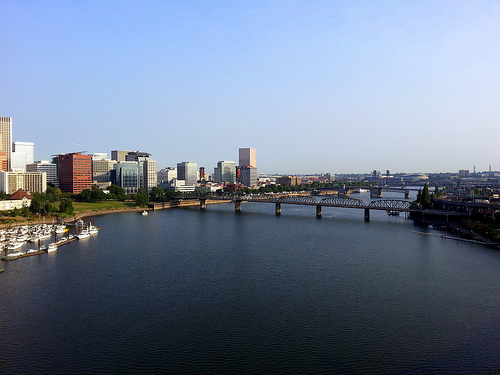Deron Lovaas, Federal Transportation Policy Director, Washington, D.C.
I am one of many longtime fans of Portland. I love the walkable streets of downtown, love the light rail that goes to the airport (PDX!), love the parks such the rose garden overlooking the city, and of course I love Powell’s book store. I have only missed one plane flight because I was enjoying myself too much, and that was at PDX several years ago.
I even love the city’s quirkiness, as captured hilariously Portlandia clips like this one:
I first studied Portland in the mid-1990s, when as part of a series of events I organized for another environmental nonprofit I contrasted their urban growth boundary (UGB) with Boulder’s growth management policy. Both were enacted in the 1970s, and that’s where the similarity ends.
While Oregon and its metro regions including Portland created demarcations for planned growth including a reserve for future development, cutting red tape and incentivizing new growth within these lines, Boulder preserved a greenbelt of land around itself and limited growth within that line by rationing building permits (here’s a good case study). The upshot for me? Oregon, and Portland, chose more wisely. One of the unintended consequences of the growth-limit policy in Boulder has been remarkably rapid sprawling development elsewhere on the Front Range of the Rockies. This is not surprising, as research shows that limiting population growth in one city or region is actually a recipe for sprawl.
In 1999 I examined Oregon again, when the Sierra Club issued the nation’s first rating of state land use, transportation, open space protection and community revitalization policies. The report, Solving Sprawl, gave Oregon the top spot for land use policy, and co-authors and I profiled their program briefly here.
In 2004, Island Press published a series of essays on Portland’s sustainability success by Portland State University authors in The Portland Edge, on which I rely for another look at the region now. In fact, here’s how the book sums up Portland’s track record:
Playing out on the demographic, economic, and civic landscapes just described, innovations in local and regional planning have contributed to Portland’s reputation as a livable place. The 1970s saw state and local policies that laid the foundation of the region’s reputation as a livable and well-planned metropolitan area. Senate Bill 10 was adopted in 1969, requiring cities and counties to prepare comprehensive land use plans that meet statewide standards. Senate Bill 100 created the Land Conservation and Development Commission in 1973 to monitor local comprehensive planning and compliance with a set of statewide planning goals. These goals are still in effect and focus comprehensively on the preservation of farmland, open space, housing, public facilities and services, urban growth boundaries, and economic development. By establishing a statewide land use planning framework in the early 1970s, Oregon was at the forefront of what is termed today the smart growth movement.
(2004-10-05). The Portland Edge: Challenges And Successes In Growing Communities (Kindle Locations 391-397). Island Press. Kindle Edition.
What have the effects of the state’s landmark policies been? A lot of land conservation, widespread availability of multiple transportation choices – walk, bike, light rail, bus – and a vibrant, walkable downtown. This yields a high quality of life, or what some call (awkwardly, I think) “livability.”
It’s also meant less traffic and driving for commuters and residents, as former Metro councilor Rex Burkholder shows in the graph below (from a 2008 PowerPoint presentation):
Less traffic, of course, means fuel savings and less pollution, including heat-trapping carbon pollution.
So how did Oregon, and Portland, get to its current enviable position vis-à-vis sustainability? It was no accident. Certain events and political leaders catalyzed dramatic changes in policy and governance 4 decades ago. This has driven the region forward, with pressure and support from non-governmental advocates and an activist citizenry (I’ve heard it said half-jokingly that “planning is in the water” in Portland).
Not that the trajectory has been without turbulence. Western state policies often face tough ballot measures, and Oregon’s landmark smart-growth statutes are no exception. And housing affordability has been fiercely debated, since Oregon property values have benefited from its livability too.
So where does Portland stand now, and where is it headed?
I will write about these issues next, and meanwhile if you have analysis, opinions or ideas to share about Portland’s sustainability I urge you to use the comment space below.
Related articles









